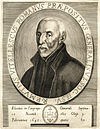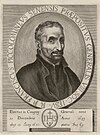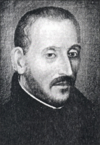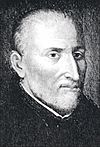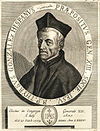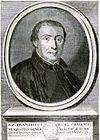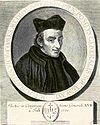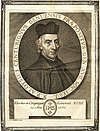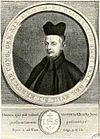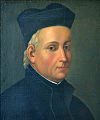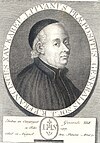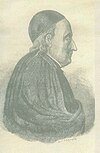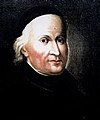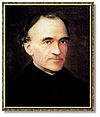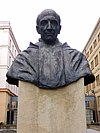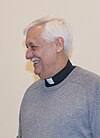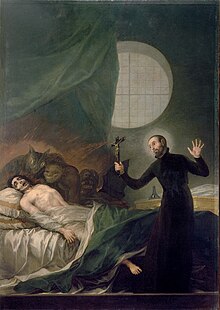
The Society of Jesus abbreviated SJ, also known as the Jesuits, is a religious order of Clerics Regular of Pontifical Right for men in the Catholic Church headquartered in Rome. It was founded in 1540 by Ignatius of Loyola and six companions, with the approval of Pope Paul III. The society is engaged in evangelization and apostolic ministry in 112 nations. Jesuits work in education, research, and cultural pursuits. Jesuits also give retreats, minister in hospitals and parishes, sponsor direct social ministries, and promote ecumenical dialogue.
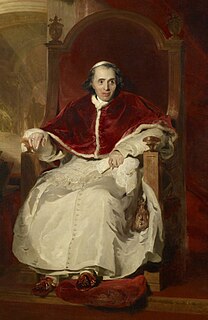
Pope Pius VII, was head of the Catholic Church and ruler of the Papal States from 14 March 1800 to his death in 1823. Chiaramonti was also a monk of the Order of Saint Benedict in addition to being a well-known theologian and bishop.

The Jesuit Refugee Service (JRS) is an international Catholic organisation with a mission to accompany, serve, and advocate on behalf of refugees and other forcibly displaced persons, that they may heal, learn, and determine their own future. Founded in November 1980 as a work of the Society of Jesus, JRS was officially registered on 19 March 2000 in Vatican City as a foundation. The impetus to found JRS came from the then superior general of the Jesuits, Pedro Arrupe, who was inspired to action by the plight of Vietnamese boat people. JRS has programmes in over 50 countries. The areas of work are in the field of education, emergency assistance, health care, livelihoods, reconciliation, and psychosocial support. JRS is also involved in advocacy and human rights work. This involves ensuring that refugees are afforded their full rights as guaranteed by the 1951 Geneva Convention relating to the Status of Refugees and working to strengthen the protection afforded to Internally displaced persons (IDPs). JRS's international headquarters is located in Rome at the Society's General Curia. The International Director is Rev. Thomas H. Smolich SJ.

Pedro Arrupe Gondra, SJ was a Spanish Basque priest who served as the 28th Superior General of the Society of Jesus from 1965 to 1983. He has been called a second founder of the Society, as he led the Jesuits in the implementation of the Second Vatican Council, especially with regard to faith that does justice and preferential option for the poor.
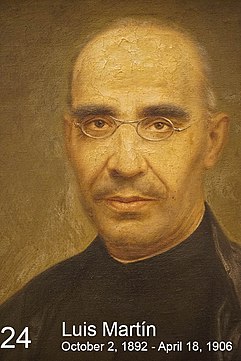
Luis Martín García was a Spanish Jesuit, elected the twenty-fourth Superior General of the Society of Jesus.

Peter Hans Kolvenbach was a Dutch Jesuit priest and professor who was the 29th superior general of the Society of Jesus, the largest male Catholic religious order.
The General Congregation is an assembly of the Jesuit representatives from all parts of the world, and serves as the highest authority in the Society of Jesus. A General Congregation (GC) is always summoned on the death or resignation of the administrative head of the order, called the Superior General or Father General, to choose his successor, and it may be called at other times if circumstances warrant. A smaller congregation of worldwide representatives meets every three years to discuss internal business and to decide the need for a general congregation.

Luigi Fortis was an Italian Jesuit elected the twentieth Superior-General of the Society of Jesus.
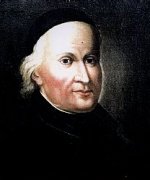
Tadeusz Brzozowski was a Polish scholar, teacher, administrator and a Jesuit priest. Having secured its continuity during the suppression of the Society until its restoration, he was elected twentieth Superior General of the Society of Jesus and was its first world-wide general.

Gabriel Gruber, S.J. was the second Superior General of the Society of Jesus in Russia.
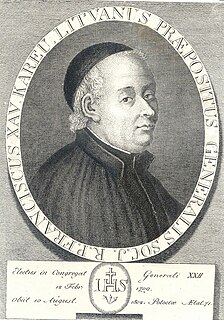
Franciszek Kareu was a Polish-British Jesuit priest, missionary and teacher in the region of modern day Belarus. He was elected Temporary Vicar General of the Society of Jesus in Russia from 1799 to 1801.
Gabriel Lenkiewicz, actually Gabriel Lenkiewicz-Ipohorski, Kotwicz coat of arms, was a Polish-Lithuanian Jesuit priest, and Temporary Vicar General of the Society of Jesus from 1785 until 1798, at a time when under Papal suppression in all Catholic countries, the Society continued in Russia.

Stanislaw Czerniewicz was a Lithuanian-Polish Jesuit priest. He was Rector of the Jesuit College in Polotsk when the Society of Jesus was suppressed in 1773; in 1782, he was elected vicar general for the Jesuits in Russia in 1782 and de facto Superior General of the Society of Jesus.

Peter Jan Beckx born in Zichem (Belgium) and died in Rome, was a Belgian Jesuit priest, elected the twenty-second Superior-General of the Society of Jesus in 1853.
Sollicitudo omnium ecclesiarum was a papal bull issued in 1814 by Pope Pius VII, reestablishing the Society of Jesus (Jesuits) after its suppression by the 1773 bull issued by Clement XIV, Dominus ac Redemptor. Nevertheless, the order continued to exist in some places. Pius VII had earlier, with the brief Catholicae Fidei, approved the existence of the Society of Jesus in Russia. The Vicar General, Franciszek Kareu, was declared "Superior General of the Jesuits in Russia."

Adolfo Nicolás Pachón was a Spanish Jesuit priest of the Catholic Church. He was the 30th Superior General of the Society of Jesus from 2008 to 2016. Before being elected Superior General, he worked primarily in Japan; he taught at Sophia University in Tokyo for twenty years and then headed educational institutions in Manila from 1978 to 1984 and in Tokyo from 1991 to 1993. He led the Jesuits in Japan from 1993 to 1996 and, after four years of pastoral work in Tokyo, led the Jesuits in Asia from 2004 to 2008.
Paolo Dezza, S.J. was an Italian Jesuit cardinal who led the Pontifical Gregorian University during the pontificate of Pope Pius XII, whom he aided in the preparation of the dogma of the Assumption of Mary. He was confessor to Pope Paul VI and Paul's successor, Pope John Paul I, and was a teacher of Pope John Paul I's successor, Pope John Paul II.
Jean-Yves Calvez was a French Jesuit, theologian, philosopher, economist, expert in Marxism and professor of social philosophy.

Arturo Marcelino Sosa Abascal is a Venezuelan Catholic priest who serves as the 31st and present superior general of the Society of Jesus. He was elected Superior General by the Society's 36th General Congregation on 14 October 2016, succeeding Adolfo Nicolás. He is the first person born in Latin America to lead the Jesuits.
Francis Dzierozynski was a Polish Catholic priest and Jesuit who became a prominent missionary to the United States. Born in the town of Orsha, in the Russian Empire, he entered the Society of Jesus and was ordained a priest in 1806. He taught and studied in Polotsk and Mogilev until leading students in an escape from the French invasion of Russia in 1812. He returned to Polotsk, where he taught until the expulsion of the Jesuits from the Russian Empire in 1820. Thereafter, he took up teaching in Bologna, Italy.










